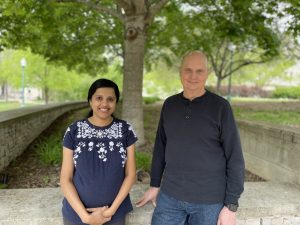Researchers at Indiana University had been in the process of studying how a childhood vaccine for rotavirus could be modified to protect against other diseases when the global pandemic hit last year.
John Patton, professor of biology and the Blatt chair of virology, and his lab team shifted gears to explore a dual vaccine that also protects against COVID-19. They reverse-engineered the rotavirus genome to make virus strains that produce the SARS-CoV-2 spike protein.
By December 2020, the scientists had encouraging proof in principle that rotavirus could be altered and used to make part of the coronavirus protein. That meant there is a good chance of inducing protection in young children for both rotavirus and COVID-19. The team was eager to share their results.
Patton and his coauthor and graduate student, Asha Philip, submitted a paper with their findings to an academic journal, but knew there would be a delay until the paper could be published. So they decided to also make their preliminary research results, Rotavirus as an Expression Platform of the SARS-CoV-2 Spike Protein, freely available as a preprint on the open-access platform bioRxiv in February, which is available on PubMed as part of the National Institutes of Health Preprint Pilot.
“We were not at all reluctant to get the information out there,” Patton says. “Much of our vaccine effort will depend on the scientific community for further development. I don’t think it benefits anyone, most assuredly those that require vaccination to escape life-threatening diseases, to withhold information on our vaccine research progress any longer than necessary.”
The COVID-19 pandemic represents the first global public health crisis in which preprints have been widely used to communicate research results. This has led to unprecedented attention on early research results, enabling an acceleration of research related to both the basic biology of SARS-CoV-2 and clinical interventions, says Jessica Polka, executive director of ASAPbio. “With many researchers being introduced to preprints for the first time, I’m hopeful that the recognized benefits of rapid sharing can be applied to many other pressing problems in the future,” she says.
The world is waiting for a vaccine that works for young children. Patton’s work is promising as it combines potential COVID-19 protection with an easy-to-use oral vaccine for rotavirus that is being rolled out globally with support from the Bill & Melinda Gates Foundation, the World Health Organization, and others.
Rotaviruses normally infect young children within the first couple years of life. It can cause severe diarrhea and rapid dehydration, and leads to an estimated 200,000 deaths per year, most oftenly occurring in developing countries. The administration of a rotavirus vaccine does not require needles, requiring only addition of sterile water to a vaccine packet, with the contents dropped into the baby’s mouth.
“The development of a combined rotavirus-SARS-CoV-2 vaccine can help control two significant human diseases,” Patton says. “Presently, rotavirus vaccines are currently given to newborns in many countries of the world, including the U.S., with ongoing efforts to expand its use to cover all babies born globally each year. Our hope is to replace the virus components of currently used rotavirus vaccines with modified reverse-engineered versions that produce the SARS-CoV-2 spike protein.” Such combined rotavirus-SARS-CoV-2 vaccines can be produced and delivered following the same approach as existing rotavirus vaccines, preventing the need to develop new and independent networks for distributing a separate SAS-CoV-2 vaccine.
The IU team results demonstrate the potential of a combined vaccine becoming a routine immunization for children in near future. Especially during a pandemic, Patton says speed and collaboration are critical so it was clear to him to share his findings in a preprint.
“It’s the right thing to do. Given the unimaginable degree of pain and suffering caused by SARS-CoV-2, there really isn’t a choice as far as I am concerned,” Patton says. “This is a new world. Preprints have an impact. People can see them and it can help to further the efforts of others. Preprints can play a critical role in bringing together the scientific insights necessary for the rapid development of effective vaccines and therapies. ”
